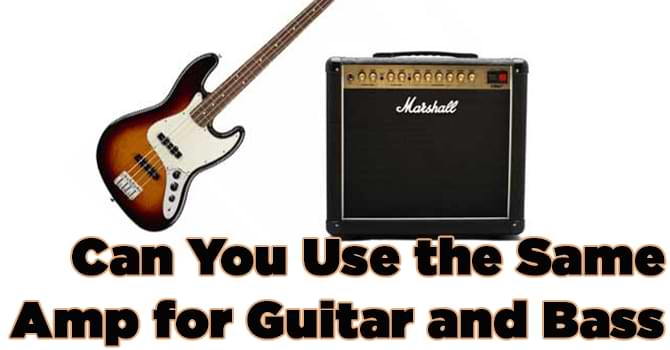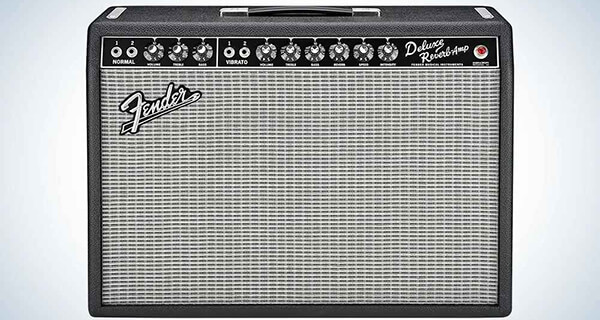Can You Use the Same Amp for Guitar and Bass [Solved]
The question of whether you can use a single amplifier for both guitar and bass has intrigued musicians for years. This debate transcends musical genres and preferences, sparking passionate discussions. Join us on this musical journey as we unravel the mysteries of dual-purpose amplification.

# Table of Contents =>
Basic of Guitar and Bass Amplification –
To understand the concept of using a single amp for both guitar and bass. It’s crucial to grasp the basics of how amplifiers work for each instrument.
a) Guitar Amplifiers:

Guitar amplifiers are designed to accentuate the unique characteristics of the electric guitar, emphasizing the instrument’s tonal qualities, overdrive capabilities, and effects processing. They typically have a narrower frequency response tailored to the guitar’s sonic range, which is richer in midrange frequencies.
b) Bass Amplifiers:

Bass amplifiers, on the other hand, are engineered to handle the lower frequencies produced by bass guitars, providing ample power to reproduce deep, punchy bass tones.
They feature a broader frequency response that emphasizes low-end frequencies and reduces the emphasis on midrange tones.
Using a Guitar Amp for Bass –
In this chapter, we explore the feasibility of using a guitar amp for bass and the potential challenges and solutions associated with this approach.
a) Advantages of Using a Guitar Amp for Bass:
Cost-effectiveness: Utilizing an existing guitar amp can save money, especially for beginners or musicians on a tight budget.
Portability: Carrying one amp for multiple instruments can be more convenient for gigging musicians with limited transportation space.
Creativity: Mixing guitar and bass tones through the same amp can lead to unique and experimental sound possibilities.
b) Challenges and Considerations:
Frequency Response: Guitar amps may lack the low-frequency response required to reproduce the full range of bass guitar tones adequately.
Overloading: Bass frequencies can push guitar amps beyond their intended limits, potentially damaging the amp and speakers.
Tone Sacrifice: Using a guitar amp for bass may result in a less-than-ideal bass tone, as it’s not optimized for low-end frequencies.
c) Workarounds and Solutions:
Use a DI (Direct Injection) Box: A DI box can be used to split the bass signal and send it to a dedicated bass amp or the PA system, while still using the guitar amp for its intended purpose.
EQ Adjustments: Experiment with the amp’s EQ settings to compensate for the lack of low-end response, although this may not fully replicate the sound of a dedicated bass amp.
Manage Volume Carefully: Be mindful of volume levels to prevent overloading the guitar amp and causing damage.
Using a Bass Amp for Guitar –
In this section, we explore the reverse scenario: using a bass amp for guitar and the pros and cons associated with this approach.
a) Advantages of Using a Bass Amp for Guitar:
Clean Headroom: Bass amps are often more powerful and have higher clean headroom, allowing for pristine amplification of guitar signals.
Balanced Sound: Bass amps offer a more neutral sound profile that can be appealing for clean and pedal-based guitar tones.
Compatibility: Using a bass amp for guitar is generally less risky than the other way around, as it’s less likely to damage the amp or speakers.
b) Challenges and Considerations:
Lack of Overdrive: Bass amps may not produce the desired over driven or distorted tones guitarists seek without pedals.
Limited Tone Shaping: Guitarists accustomed to the tonal flexibility of guitar amps may find bass amps less versatile in terms of EQ and effects.
c) Workarounds and Solutions:
Pedalboard Integration: To achieve the desired guitar effects and overdrive, use a pedal board in conjunction with the bass amp.
Tweaking EQ: Experiment with the bass amp’s EQ settings to sculpt your guitar’s sound as best as possible.
Mixing with Another Amp: Consider blending the bass with a guitar amp for a fuller and more dynamic sound.
Versatile Amps for Both Guitar and Bass –
Some amplifiers are specifically designed to accommodate both guitar and bass, offering a compromise between dedicated amplifiers. In this chapter, we explore these versatile options.
a) Combo Amps:
Combo amplifiers with multiple channels and EQ settings can serve as a middle ground, allowing you to switch between guitar and bass inputs. These amps often include features like built-in effects and speaker configurations designed to handle both instruments effectively.
b) Modeling Amps:

Modeling amplifiers equipped with digital technology provide a wide range of amp and effect simulations, making them suitable for both guitar and bass players. These amps can replicate the characteristics of various amplifiers, giving you flexibility in crafting your desired tone.
Tips for Optimal Results –
To make the most of using the same for both guitar and bass, consider these practical tips:
Experimentation: Don’t be afraid to experiment with different settings, EQ adjustments & pedal combinations to find the right sound for your music.
Volume Management: Pay close attention to volume levels to prevent damaging your amp and speakers.
Speaker Matching: If using a single amp for both instruments, choose a speaker that can handle the wide frequency range produced by both guitar and bass.
Backup Plan: Always have a backup amp or plan in case your primary amp fails during a performance.
Conclusion:
While using the same amplifier for both guitar and bass is possible, it comes with its share of challenges and limitations. Musicians should carefully consider their specific needs, budget, and sonic preferences when deciding whether to opt for a single amp or invest in dedicated amplifiers for each instrument.
Ultimately, the choice will depend on individual circumstances, but with the right knowledge and precautions, you can make the most out of your equipment and produce exceptional music regardless of your amp choice.
Last Updated on October 13, 2023 by Perry Garner


